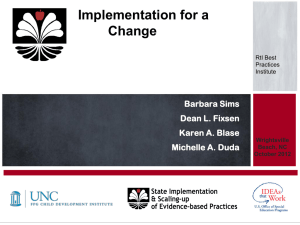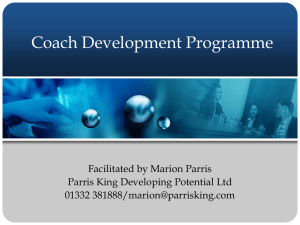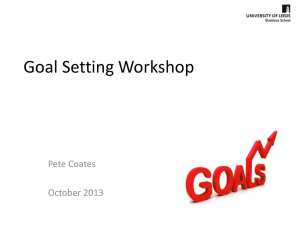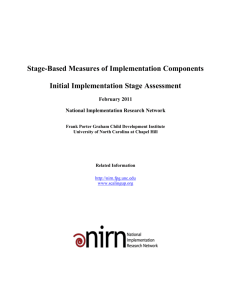Implementation Science Powerpoint
advertisement
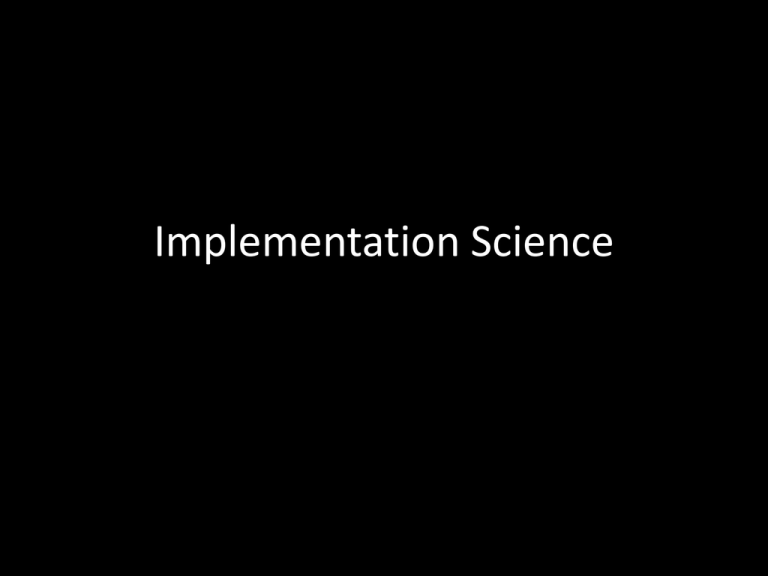
Implementation Science Lessons Learned… “It's a wise man who profits by his own experience, but it's a good deal wiser one who lets the rattlesnake bite the other fellow” Josh Billings Stages of Implementation Exploration/Ad option Development Commitment and acquiring more information about the innovation Installation Creating the systems and materials to prepare for implementation Initial Implementation Provide Significant Support to Implementers; implementer is focused on shortterm day to day use of the innovation with little time for reflection Full Implementation Use of the innovation is stabilized. Few if any changes are being made in ongoing use Elaboration (Innovation) Embedding within Standard Practice and is able to find ways to make the innovation more efficient Continuous Regeneration (Sustainability) Improvements: Increase Efficiency and Effectiveness Exploration/Ad option Development Commitment and acquiring more information about the innovation Exploration/Adoption • Assess capacity, resources, and buy-in • Begin developing awareness and support for adoption (parents, staff, central office) • Explain the risks involved in adopting (“What will be different for us as a result?”) • Identify staff who will be comfortable managing the risks (change in practice, ambiguity) for leadership roles Exploration/Ad option Development Commitment and acquiring more information about the innovation Exploration/Adoption • Assess whether you will have access to experts (trainers, coaches, colleagues) who know the innovation well • Build consensus and commitment for adoption More about developing consensus is coming up next! Installation Creating the systems and materials to prepare for implementation Installation • Create “space” for the work to happen • Begin recruiting and hiring staff • Conduct training Installation Creating the systems and materials to prepare for implementation Installation • Develop the infrastructures to support implementation – On-going training – Coaching and supervision – Staff and fidelity evaluations – Outcome evaluations – How will the work get done? Committees, regular meeting times, how often, how long Initial Implementation Provide Significant Support to Implementers; implementer is focused on shortterm day to day use of the innovation with little time for reflection Initial Implementation • “You cannot do something well without doing it poorly first!” • Survive the awkward stage – Learn from mistakes-implementation will feel messy! – Continue “buy-in” efforts-people will ask, “What the heck did I agree to do?!” – Manage expectations- keep people focused on what is expected for implementation Initial Implementation Provide Significant Support to Implementers; implementer is focused on shortterm day to day use of the innovation with little time for reflection Initial Implementation • Change practices • Put the components you have been planning (infrastructures to implement) in place • Change organizational and community structures and culture • Manage the change process- “Nope, I change my mind!” • Overcome fear and inertia- “I feel like a failure” Full Implementation Use of the innovation is stabilized. Few if any changes are being made in ongoing use Full Implementation • Implementers are in a routine while implementing the innovation – Comfortable with the materials and components of the innovation • Implementation is not awkward • Few if any changes are made in the on-going use of the innovation Elaboration (Innovation) Embedding within Standard Practice and is able to find ways to make the innovation more efficient Elaboration (Innovation) • Replicate school implementations within the district based on initial implementation – Select a model demonstration site(s) and then learn from implementation efforts – Let early adopters make the mistakes first – Continue to refine systems that support how data are analyzed and how decisions are made Elaboration (Innovation) Embedding within Standard Practice and is able to find ways to make the innovation more efficient Elaboration (Innovation) • Ensure feedback loops are in place between the implementation support systems – Building leadership team Planning Team Implementation • All the components of the innovation are in place and fully functioning Continuous Regeneration (Sustainability) Improvements: Increase Efficiency and Effectiveness Continuous Regeneration (Sustainability) • It is important to first, do it right (fidelity), then do it better (innovate) • Continuous Regeneration is doing it better – More efficient with implementation • It is important to have feedback loops in place to review data to determine if alterations to the innovation are still positively impacting student outcomes Continuous Regeneration (Sustainability) Improvements: Increase Efficiency and Effectiveness Continuous Regeneration (Sustainability) • Consultation with: – Experts, trainers, coaches, colleagues • Systems adoption within the district – New staff orientation – Should get easier over time These stages are recursive: Setbacks at one stage moves us back to the previous stage Ignore File Grievance Snow Day! Data Vote coach off Change Practice Violate Norms Have a “AHA!” Dominate conversation Go to Book Study Late for meeting Ignore emails Go to a PLC Apply for PBIS Prep for Meeting New State Initiative “We already do that.” New District Initiative Today is a book study? Attend District PD Be on time Stages of Implementation Establishing consensus is a recursive process. Managing the change process requires the leader to monitor the pulse of staff Exploration/Ad option Development Commitment and acquiring more information about the innovation Installation Creating the systems and materials to prepare for implementation Principals should anticipate staff who will perceive the change as first or second order before Exploration. When Exploration begins, it will become apparent Initial Implementation Provide Significant Support to Implementers; implementer is focused on shortterm day to day use of the innovation with little time for reflection Full Implementation Use of the innovation is stabilized. Few if any changes are being made in ongoing use Elaboration Embedding within Standard Practice and is able to find ways to make the innovation more efficient Continuous Regeneration Improvements: Increase Efficiency and Effectiveness Understanding People’s Concerns about Implementation Leading Change is Hard Work! Implementation Takes Time •Exploration (Sustainability) •Installation (Sustainability) •Initial Implementation •Full Implementation (Effectiveness & Sustainability) 2–4 Years Fixsen, Naoom, Blase, Friedman, & Wallace, 2005 Change is Cyclical and Iterative-Exploration Installation Implementation 7. Special Ed Referral and Evaluation Report 6. Teaming/Data-Based Decision Making: Individual Problem Solving 5. Teaming/Data-Based Decision Making: Group Interventions 4. Progress Monitoring 3. Interventions with Fidelity 2. Core Instruction with Fidelity 1. Screening Competency Drivers Organization Drivers Leadership Implementation Science Know Your Driver Implementation Drivers Sustainable Student Outcomes Performance Assessment (Fidelity) Systems Intervention Coaching Training Selection Facilitative Administration Integrated & Compensatory Decision Support Data System Leadership Adaptive Technical © Fixsen & Blase, 2008 Sustainable Student Outcomes Effective Implementation of Evidence Based Practice (e.g. RtI) Selection Integrated & Compensatory Leadership © Fixsen & Blase, 2008 Sample Interview Questions for Elementary Principal Position • If you were to walk into a classroom with excellent instruction, what would you expect to see? • If you were to walk into a classroom with poor instruction, what would you do about it? • What are the common features of Positive Behavior Intervention Support and Response to Intervention systems? What is your experience coordinating, leading, or performing within these systems? • How would you teach reading to a 1st grader? Interview Data Activity Directions: Please review the data provided for the following six (6) students. At the bottom of each page, please complete the instructional recommendation section and include your rationale. Selection gone wrong Sustainable Student Outcomes Effective Implementation of Evidence Based Practice (e.g. RtI) Training Selection Integrated and Compensatory Leadership © Fixsen & Blase, 2008 Implementation Driver: Training Purpose: Train staff in specific skills needed to implement the EBP • Created a PD plan that is developed collaboratively across departments • PD continually recycles key elements (i.e., core) to address drift and train new staff • Data from fidelity measures (SET, EBIS Group Planning Form, etc) used to inform PD plan • Data from outcome measures (DIBELS, Maze, OAKS) used to inform PD plan Implementation Driver: Training • New staff receive an extra five days of training and extra coaching throughout the year that focuses on EBIS components • All PBIS teams get a full day each year for training, coaching, and time to plan • All principals trained to conduct walkthroughs and instructional rounds for coaching and instructional leadership Sustainable Student Outcomes Effective Implementation of Evidence Based Practice (e.g. RtI) Coaching Training Selection Integrated and Compensatory Leadership © Fixsen & Blase, 2008 Implementation Driver: Coaching Purpose: Ensure transfer from training to practice • A “Coaching Delivery Plan” is developed • Lead Person is designated and supported • Coaches are fluent with RTI and PBIS • Feedback from multiple sources is collected, provided to practitioners and used to determine areas in need of more coaching and training Implementation Driver: Coaching Joyce and Showers, 2002 TRAINING COMPONENTS OUTCOMES (% of Participants) Demonstrate Knowledge Demonstrate Skill Use in the Classroom Theory and Discussion 10% 5% 0% + Demonstration in Training 30% 20% 0% + Practice & Feedback in Training 60% 60% 5% 95% 95% 95% + Coaching in Classroom Implementation Driver: Coaching District level coaching – Attend grade level EBIS meetings – Provide feedback using Coaching Rubric – Facilitate monthly meetings with school literacy coaches, counselors and principals – Update EBIS Handbook annually Implementation Driver: Coaching School level coaching: – Principal lead walkthroughs/Instructional rounds – Literacy specialists coach teachers and instructional assistants on instructional practices and literacy across content areas – Counselors and PBIS team members coach teachers and instructional assistants on behavior Sustainable Student Outcomes Effective Implementation of Evidence Based Practice (e.g. RtI) Performance Assessment (Fidelity) Coaching Training Selection Coaching Training Integrated and Compensatory Selection Leadership © Fixsen & Blase, 2008 Implementation Driver: Performance Assessment Purpose: Ensure EBP is Implemented with fidelity • Performance of practices, teams and coaches are assessed at least annually. (Quarterly until fidelity is reached.) • Assessment measures include direct observation, and review of fidelity and outcome measures. • Feedback is provided and successes are celebrated Implementation Driver: Performance Assessment Data Sources:Improvement Plan goals Continuous Elementary School Literacy Plans • and Fidelity Assessment: SET, are directly linked to these measures. Benchmarks of Quality, EBIS Group Planning Form, Coaching Rubric, Walk Through Forms • Outcome measures: DIBELS, Maze, OAKS • Annual EBIS Systems Assessment: DSSP Sustainable Student Outcomes Effective Implementation of Evidence Based Practice (e.g. RtI) Performance Assessment (Fidelity) Coaching Training Selection Integrated & Compensatory Leadership Decision Support Data System © Fixsen & Blase, 2008 Implementation Driver: Decision Support Data System Purpose: Employ data systems that guide MTI and RTI practices in order to increase student achievement Implementation Fidelity Assessments • • • • Data from SET (School-wide Evaluation Tool) Coaching Rubric, walk through form, etc. Elementary EBIS Team Planning Survey Annual EBIS Systems Assessment: DSSP Implementation Driver: Decision Support Data System Student Performance Measures – Outcomes measures: OAKS, ODRs, DIBELS – Universal Screening: DIBELS, OAKS, ODRs, Maze – Progress Monitoring: Curriculum Based Measures (AIMSweb, DIBELS) – Diagnostic Measures: Grade +, Phonics Screener Sustainable Student Outcomes Effective Implementation of Evidence Based Practice (e.g. RTI) Performance Assessment (Fidelity) Coaching Facilitative (Barrier Busting) Administration Training Selection Integrated and Compensatory Leadership Decision Support Data System © Fixsen & Blase, 2008 Implementation Driver: Facilitative Administration Purpose: To ensure that administrators provide staff with support to implement EBP AND ensure that staff are implementing with fidelity. Support •Schedule •Resources •Training •Procedures Monitoring •Fidelity checks •Principal Walk Throughs •Staff Evaluation process Sustainable Student Outcomes Effective Implementation of Evidence Based Practice (e.g. RtI) Performance Assessment (Fidelity) Systems Intervention Coaching Facilitative Administration Training Selection Integrated and Compensatory Leadership Decision Support Data System © Fixsen & Blase, 2008 Implementation Driver: Systems Intervention – Engage and grow “champions” – District leadership actively participates with state education department agencies and legislature – Multiple district and school level teams engage in reciprocal communication (PEP – PIP cycles) – Positive feedback provided to schools on achieving CIP Goals Sustainable Student Outcomes Effective Implementation of Evidence Based Practice (e.g. RtI) Performance Assessment (Fidelity) Coaching Systems Intervention Training Selection Facilitative Administration Integrated and Compensatory Leadership Adaptive Technical Decision Support Data System © Fixsen & Blase, 2008 Adaptive vs Technical Leadership VS Lessons Re-Learned… OR What SISEP Has Taught Us! 1. 2. 3. 4. 5. 6. Pick the right people Teach them what to do Coach them Make sure they’re doing it right Determine if the system is working Keep lines of communication open and support your people 7. Get help from everyone you can 8. Celebrate success! “About the most originality that any writer can hope to achieve honestly is to steal with good judgment”. Josh Billings





